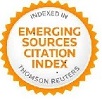An Approach to the Study of Failed Battle Exhortation Speeches: Livius, Lucan and Silius Italicus
Keywords:
Failed harangue, Livy, Lucan, Silius Italicus, Historiography, EpicAbstract
The failed battle exhortation speeches have not been so far analyzed in a systematic way. This paper proposes a critical approach to this kind of speech in both Roman historiography and epic. Since the number of examples is not very high, we will study all of them in order to show theirvalue and function they fulfill. Authors (Livy, Lucan and Silius Italicus) have been selected taking into accountthe thematic and intertextual relationships among them.
Downloads
References
AHL, F. (1976), Lucan. An Introduction, Ithaca y Londres.
AHL, F.- DAVIS, M.-POMEROY, A. (1986), “Silius Italicus”, ANRW 2.32.4,cols. 2492-2561.
AUGOUSTAKIS, A., ed. (2010), Brill’s Companion to Silius Italicus, Leiden y Boston.
BARTOLOMÉ, J. (1995), Estudio literario de los relatos bélicos de la primera década de Ab Vrbe Condita de Tito Livio, Vitoria-Gasteiz.
BATSTONE, W. W. (2010), “Catiline’s Speeches in Sallust’s Bellum Catilinae”, en D. H. Berry y A. Erskine (eds.), Form and Function in Roman Oratory, Cambridge, pp. 227-246.
BERNARD, J.-E (2000), Le portrait chez Tite-Live. Essai sur une écriture de l’histoire romaine, Bruselas.
BURCK, E. (1992), Das Geschichtswerk des Titus Livius, Heidelberg.
CARMONA CENTENO, D. (2014) La escena típica de la epipólesis. De la épica a la historiografía,Roma.
CHAPLIN, J. D. (2000), Livy’s Exemplary History, Oxford.
CHASSIGNET, M. (2009),“Discours prononcés, discours écoutés chez Tite-Live: l’exemple des discours du livre XXI de l’AbVrbe Condita”, en G. Abbamonte-L. Miletti-L. Spina, eds., Discorsi alla prova. Atti del Quinto colloquio italo-francese Discorsi pronunciati, discorsi ascoltati: contesti di eloquenza tra Grecia, Roma ed Europa, Napoli-S. Maria di Castellabate 21-23 settembre 2006, Nápoles, pp. 87-102.
CHAUDHURI, P. (2013) “Flaminius’ failure? lntertextual Characterization in Silius ltalicus and Statius”, en G. Manuwald and A. Voigt, eds., Flavian Interactions, Berlín y Boston, pp. 379-397.
FANTHAM, E. (1985), “Caesar and the Mutiny: Lucan’s Reshaping of the Historical Tradition in De bello civili5. 237-373”, CPh89, 119-131.
FANTHAM, E. (1992), Lucan. De bello civili Book II, Cambridge.
FUCECCHI, M. (1990a),“Empietà e titanismo nella rappresentazione siliana di Annibale”, Orpheus 11, 21-42.
FUCECCHI, M. (1990b),“Il declino di Annibale nei Punica”, Maia 42, 151-166.
FUCECCHI, M. (2009),“The Shield and the Sword: Q. Fabius Maximus and M. Claudius Marcellus as Models of Heroism in Silius’ Punica”, en A. Augoustakis (ed.), pp. 219-240.
GOEBEL, G. H. (1981), “Rhetorical and Poetical Thinking in Lucan’s Harangues (7.250-382)”, TAPhA 111,
-94.
HARTO TRUJILLO, Mª L. (2008), Las arengas militares en la historiografía latina, Madrid.
HELZLE, M. (1994), “Indocilis privata loqui:The Characterization of Lucan's Caesar”, SO 69, 121-136.
IGLESIAS ZOIDO, J. C. (2007), “The Battle Exhortation in Ancient Rhetoric”, Rhetorica 25, 141-158.
IGLESIAS ZOIDO, J. C., ed. (2008a), Retórica e Historiografía. El discurso militar en la historiografía desde la Antigüedad hasta el Renacimiento, Madrid.
IGLESIAS ZOIDO, J. C. (2008b),“La arenga militar en la historiografía griega: el modelo de Tucídides y sus antecedentes literarios y retóricos”, en Iglesias-Zoido (ed.), pp. 231-258.
IGLESIAS ZOIDO, J. C. (2010), “Aproximación a las claves de la más reciente investigación sobre la arenga militar (2008-2010)”, Talia Dixit 5, 91-110.
KEITEL, E. (1987), “Homeric Antecedents to the Cohortatioin the Ancient Historians”, CW 80, 153-172.
LAIRD, A. (1999), Powers of Expression, Expressions of Power. Speech Presentation and Latin Literature, Oxford.
LAIRD, A. (2009), “The Rhetoric of Roman Historiography”, en A. Feldherr, ed., The Cambridge Companion to the Roman Historians, Cambridge, pp. 197-213.
LAUSBERG, M,(1985),“Lucan und Homer”, ANRW 2.32.3, cols.1565-1622.
LEVENE, D. S. (1993), Religion in Livy, Leiden.
LEVENE, D. S. (2009), Livy. On the Hannibalic War, Oxford.
LITTLEWOOD, R. J. (2011), A Commentary on Silius Italicus’ Punica 7, Oxford.
MANZANO VENTURA, Mª V. (2010), Los discursos de exhortación militar en la “Farsalia” de Lucano, Madrid.
MARINCOLA, J. (2007), “Speeches in Greek and Roman Historiography”, en Id., ed., A Companion to Greek and Roman Historiography, Londres, pp. 118-132.
MARKS, R. (2005), From Republic to Empire. Scipio Africanus in the Punica of Silius Italicus, Frankfurt an Main.
MATHEWS, M. (2008), Caesar and the Storm. A Commentary on Lucan De bello civili, Book 5 lines 476-721, Berna.
NARDUCCI, E. (2002), Lucano. Un’epica contro l’impero, Roma.
NIEMANN, K. H. (1975), Die Darstellung der römischen Niederlagen in del Punica des Silius Italicus, Bonn.
OAKLEY,S. (1999), A Commentary on Livy, Books VI-X: Volume I: Book VI, Oxford.
OAKLEY, S. (2005), A Commentary on Livy, Books VI-X: Volume IV: Book X, Oxford.
PANIAGUA, D. (2007), “La arenga militar desde la perspectiva de la tradición polemológica grecolatina”, Talia Dixit 2, 1-25.
RADICKE, J. (2004), Lucans poetische Technik: Studien zum historischen Epos, Leiden.
ROCHE, P. (2009), Lucan. De bello Ciuili, Book I. Edited with Introduction, Text and Commentary, Oxford.
ROLLER, M. (1996), “Ethical Contradiction and the Fractured Community in Lucan’s Bellum Civile”, CA 15, 319-347.
SPALTESTEIN , F. (1986,1990), Commentaire des Punica de Silius Italicus, vol. I: livres 1 à 8; vol II: livres 9 à17, París
TASLER, W. (1972), Die Reden in Lucans Pharsalia, Bonn.
TIPPING, B. (2009), “Virtue and Narrative In Silius Italicus’ Punica”, en A. Augoustakis, (ed.), pp. 193-218
TIPPING, B. (2010), Exemplary Epic. Silius Italicus’ Punica, Oxford.
TREPTOW, R. (1964), Die Kunst der Reden in der 1. und 3. Dekade des livianischen Geschichtswerkes, Kiel.
VILLALBA ÁLVAREZ, J. (2008), “Épica e historiografía: las arengas en los Punica de Silio Itálico y su relación con Tito Livio”, en J. C. Iglesias Zoido (ed.), pp. 341-366.
VON ALBRECHT, M. (1964), Silius Italicus. Freiheit und Gebundenheit römischer Epik, Amsterdam.
WEBB, R. (1997) “Imagination and Arousal of the Emotions in Greco-Roman Rhetoric”, en S. Braund y Ch. Gill (eds.), The Passions in Roman Thought and Literature, Cambridge, pp. 113-127.
YELLIN, K. (2008), Battle Exhortation. The Rhetoric of Combat Leadership, Columbia (South Caroline).












